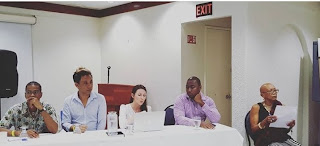Hate crime vs Hate Incident and Joseph Sanchez
14th January, 2014
Was it a crime of passion? Was it a hate crime or incident? That is what a community is asking itself ! The police suggests the motive was robbery, the family disputes that. UniBAM says the murder of Joseph Sanchez was a hate crime. What do we really know? First let us define what is a hate crime and how the laws are structured in other countries. We know, hate crime laws speak to the following:
In an Amandala Report dated January 14th, 2014 the article can be quoted as saying:
"Sanchez’s family is disputing the police’s theory that his death is as the result of a robbery, however. They say that that theory does not hold water because his cell phone and money were not stolen. They believe that the well-known cross-dresser was killed simply because he liked to dress as a woman."
"She said that he had been receiving death threats, and had been told on several occasions that he would be killed."
" Abner Sanchez, Joe’s brother, said that his brother was frequently harassed and threatened because he dressed in women’s clothing."
"Abner said that when he saw his brother at the morgue, he saw marks on his hands and face which made him believe that Joe fought with his attackers. He believed his brother was lured out of their house, and that whoever did so intended to kill him. He said that his brother’s phone had been handed over to police."
"A man who thought that he was a girl began to come to the house for him, but would stay at a distance, said Abner. When the man found out that the “girl” was really a man, he began to threaten him."
Even when one looks at at the channel five interview, the brother alluded to," di man neva know he da wa man, so it look like when dat person fine out he da wa male (see link below), is when e start d death threats after a." Joseph, may have been robbed and stabbed in the chest, its clear that it was not just a robbery. Despite the reporter leading comments, the case is not so cut and dry.
A case in the US, that happened in 2002 points out, even if the person had sex with the victim and engaged in sexual acts with the defendant, the bias motivation was what matters. In this case the 17 year old, Araujo, from Newark, was kicked, beaten in the head with a shovel and strangled by a rope at a home in the southern Alameda County city the night of October 3, 2002. Prosecutors say Gewn Araujo, born Edward Araujo had engaged in sexual acts with at least two of the defendants going back several weeks before the slaying. The perpetrators of the crime was charged with a hate cime (see link below).
In Andorra, discriminatory acts constituting harassment or infringement of a person's dignity on the basis of origin, citizenship, race, religion, or sex (Penal Code Article 313). Courts have cited bias-based motivation in delivering sentences, but there is no explicit penalty enhancement provision in the Criminal Code.
While language may differ between countries, the intent or structure of the laws don't change that dramatically. For Belize, we do not have a definition for hate crime and the police is under no legal obligation to say anything else so we remain in limbo as to the motive and the identification of the suspects.
http://fateh.sikhnet.com/s/HateCrimeInfo
http://amandala.com.bz/news/cross-dresser-stabbed-dead/
http://www.sfgate.com/bayarea/article/One-year-since-transgender-teen-s-death-Gwen-2584451.php
http://www.youtube.com/watch?v=yy72RV29E_A&feature=youtu.be)
http://en.wikipedia.org/wiki/Hate_crime
Was it a crime of passion? Was it a hate crime or incident? That is what a community is asking itself ! The police suggests the motive was robbery, the family disputes that. UniBAM says the murder of Joseph Sanchez was a hate crime. What do we really know? First let us define what is a hate crime and how the laws are structured in other countries. We know, hate crime laws speak to the following:
- laws defining specific bias-motivated acts as distinct crimes;
- criminal penalty-enhancement laws;
- laws creating a distinct civil cause of action for hate crimes; and
- laws requiring administrative agencies to collect hate crime statistics.
Hate crimes are criminal acts--such as vandalism, arson, assault, or murder--committed against someone because of his or her race, religion, sexual orientation, ethnicity, disability, age, or gender. In a hate crime, the person is selected because of a characteristic that he or she cannot change. Hate incidents are actions motivated by prejudice that aren't necessarily crimes, but are harmful nonetheless. A hate incident is any act, whether consisting of conduct, speech, or expression, to which a bias motive is evident as a contributing factor, without regard for whether the act constitutes a crime. Hostile or hateful speech, for example may be motivated by bias but is not illegal. They become crimes only when they directly incite perpetrators to commit violence against persons or property, or if they place a victim in reasonable fear of physical injury. So let's look at the comments from the family in a couple of the interviews
In an Amandala Report dated January 14th, 2014 the article can be quoted as saying:
"Sanchez’s family is disputing the police’s theory that his death is as the result of a robbery, however. They say that that theory does not hold water because his cell phone and money were not stolen. They believe that the well-known cross-dresser was killed simply because he liked to dress as a woman."
"She said that he had been receiving death threats, and had been told on several occasions that he would be killed."
" Abner Sanchez, Joe’s brother, said that his brother was frequently harassed and threatened because he dressed in women’s clothing."
"Abner said that when he saw his brother at the morgue, he saw marks on his hands and face which made him believe that Joe fought with his attackers. He believed his brother was lured out of their house, and that whoever did so intended to kill him. He said that his brother’s phone had been handed over to police."
"A man who thought that he was a girl began to come to the house for him, but would stay at a distance, said Abner. When the man found out that the “girl” was really a man, he began to threaten him."
Even when one looks at at the channel five interview, the brother alluded to," di man neva know he da wa man, so it look like when dat person fine out he da wa male (see link below), is when e start d death threats after a." Joseph, may have been robbed and stabbed in the chest, its clear that it was not just a robbery. Despite the reporter leading comments, the case is not so cut and dry.
A case in the US, that happened in 2002 points out, even if the person had sex with the victim and engaged in sexual acts with the defendant, the bias motivation was what matters. In this case the 17 year old, Araujo, from Newark, was kicked, beaten in the head with a shovel and strangled by a rope at a home in the southern Alameda County city the night of October 3, 2002. Prosecutors say Gewn Araujo, born Edward Araujo had engaged in sexual acts with at least two of the defendants going back several weeks before the slaying. The perpetrators of the crime was charged with a hate cime (see link below).
In Andorra, discriminatory acts constituting harassment or infringement of a person's dignity on the basis of origin, citizenship, race, religion, or sex (Penal Code Article 313). Courts have cited bias-based motivation in delivering sentences, but there is no explicit penalty enhancement provision in the Criminal Code.
While in the Czech Republic its different. The Czech legislation finds its constitutional basis in the principles
of equality and non-discrimination contained in the Charter of
Fundamental Rights and Basic Freedoms. From there, we can trace two
basic lines of protection against hate-motivated incidents: one passes
through criminal law, the other through civil law. The current Czech
criminal legislation has implications both for decisions about guilt
(affecting the decision whether to find a defendant guilty or not
guilty) and decisions concerning sentencing (affecting the extent of the
punishment imposed). It has three levels, to wit: • a circumstance determining whether an act is a crime
– hate motivation is included in the basic constituent elements. If
hate motivation is not proven, conviction for a hate crime is not
possible. • a circumstance determining the imposition of a higher penalty
– a hate motivation is included in the qualified constituent elements
for some types of crimes (murder, bodily harm). If hate motivation is
not proven, the penalty is imposed according to the scale specified for
the basic constituent elements of the crime. • general aggravating circumstance
– the court is obligated to take the hate motivation into account as a
general aggravating circumstance and determines the amount of penalty to
impose. Nevertheless, it is not possible to add together a general
aggravating circumstance and a circumstance determining the imposition
of a higher penalty. (see Annex for details) Current criminal
legislation does not provide for special penalties for acts that target another by reason of his sexual orientation, age or health status.
Only the constituent elements of the criminal offense of Incitement to
hatred towards a group of persons or to the curtailment of their rights
and freedoms, and general aggravating circumstances include attacking a
so-called different group of people. Such a group of people can then, of
course, be also one defined by sexual orientation, age or health
status. A certain disparity has thus been created between, on the one
hand, those groups of people who are victimized by reason of their skin
color, faith, nationality, ethnicity or political persuasion and enjoy
increased protection, and, on the other hand, those groups that are
victimized by reason of their sexual orientation, age or health status
and are not granted increased protection. This gap in protection against
attacks motivated by the victim's sexual orientation, age or health
status cannot be successfully bridged by interpretation. Interpretation
by analogy is inadmissible in criminal law, sanctionable motivations
being exhaustively enumerated.
While language may differ between countries, the intent or structure of the laws don't change that dramatically. For Belize, we do not have a definition for hate crime and the police is under no legal obligation to say anything else so we remain in limbo as to the motive and the identification of the suspects.
http://fateh.sikhnet.com/s/HateCrimeInfo
http://amandala.com.bz/news/cross-dresser-stabbed-dead/
http://www.sfgate.com/bayarea/article/One-year-since-transgender-teen-s-death-Gwen-2584451.php
http://www.youtube.com/watch?v=yy72RV29E_A&feature=youtu.be)
http://en.wikipedia.org/wiki/Hate_crime





Comments
Post a Comment